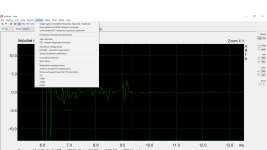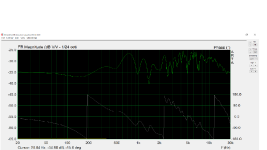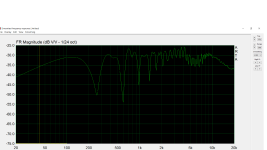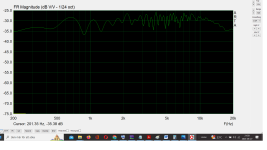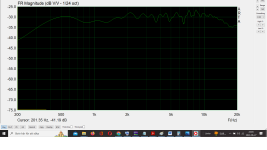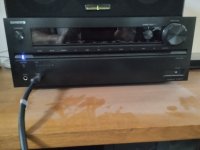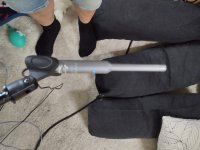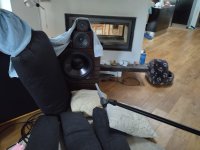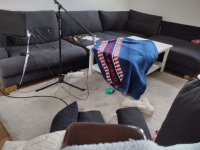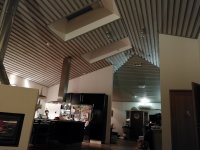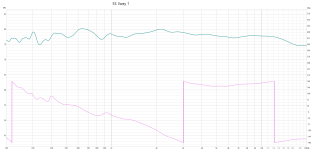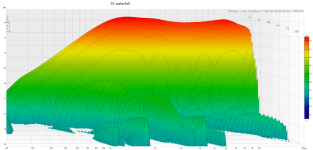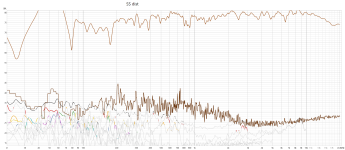Okey, but where is "the button" gated frequency response in Arta?choose ‘gated frequency response’.
Have look for it but dont find it, and under button "Analysis" at the top there is something named "Single-gated smoothed frequency respons / Spectrum"....... Is it that button? (se pic)
Attachments
Yep, that’s it. The other ‘gated’ one (dual gated?) averages a 200ms gate in room response with the user preset gate. Comes in handy when evaluating loudspeaker in room, but not for loudspeaker development.
Do not apply too much smoothing. 1/24 or 1/12 is ok.
Do not apply too much smoothing. 1/24 or 1/12 is ok.
Yep, that’s i
Do not apply too much smoothing. 1/24 or 1/12 is ok.
Don´t understand much of this screen, but have 1/24 smoothing on this pic.
Notice BIG variations depend on exact where you put "left" vertical line.
regards John
Attachments
The biggest happen when placing the right marker too far to the right. A typical reasonably performed gated measurement looks like this:

You see the low end going down because the gate becomes too short to record low frequency signals. Above that, the response should be solely that of the speaker.
Your measurement (still) shows lots of interferences, probably due to reflecting surfaces very close to,the speaker or to the microphone, within the gated measurement. That also shows in the impulse response as I wrote.
You see the low end going down because the gate becomes too short to record low frequency signals. Above that, the response should be solely that of the speaker.
Your measurement (still) shows lots of interferences, probably due to reflecting surfaces very close to,the speaker or to the microphone, within the gated measurement. That also shows in the impulse response as I wrote.
Yes that's what happens regarding where you position the lefthand cursor.
Play with them both and get a better feel for how they work. for the LHS try different positions just before the peak and then move towards the impulse peak. Then try the right hand edge between 3 to 9 mS behind the front cursor. 3ms in time axis approx. 1 metre distance, so if you did measurement's at 2 metres you will be somewhere around the 6ms after the front cursor.
Play with them both and get a better feel for how they work. for the LHS try different positions just before the peak and then move towards the impulse peak. Then try the right hand edge between 3 to 9 mS behind the front cursor. 3ms in time axis approx. 1 metre distance, so if you did measurement's at 2 metres you will be somewhere around the 6ms after the front cursor.
According to my feeling when playing a little with the left cursor/ right cursor, the program/Arta/impule "analys" is way to sensitive and irregular.Yes that's what happens regarding where you position the lefthand cursor.
The variations/outcomming "of the analyst" are extremely large when you move the cursor just a few mm, that don´t feel right to me.
A measurement is what it is, but Arta "make" the result of the same measurement to fluctuates a lot just because of "setting the cursor" 1-2 mm left or right.
That dont seems right to my when the same measurement´can "come out" quite good BUT also look like crap.
Attachments
Ok, the changes happen due to the small windows lack of resolution of low frequencies i.e. a window length of 3 mS gives a resolution limit of 1/0.003 = 333 Hz approx. values below that are not accurate data, and should be be ignored. Notice how the low frequency measurement data is smoother that the high frequencies simply because of this. also maybe dropping the octave resolution to 6 or 12 dB per octave smooths this even more I personally like to work with this kind of data, others have their own preference and maybe where they make there measurements are less reflective or they use drapes and duvets or acoustic foam to quieten down their measurement area. Obviously a manufacturer will have a large enough anechoic chambers to get clean and accurate low frequency data, diyer's have to work a bit harder at getting accurate quasi anechoic and near field date combined to get close to an anechoic measurement
To get more accurate and sensible data the the real low frequency response has to be measured with the microphone almost touching the cone.
This measurement can then be scaled down in amplitude and then sliced to the gated measurement somewhere between 300-400Hz. the output of a reflex port can also be factored in with the correct scaling in this case the ratio of the port to woofer size. Take a look here for some further info.
https://www.diyaudio.com/community/...d-measurements-in-general.390274/post-7122541
https://www.diyaudio.com/community/threads/scaling-port-response-to-speaker-nearfield.351605/
If you want more info have a search on quasi anechoic measurements and splicing low frequency data. Its also in the VituixCad help file if I remember correctly.
To get more accurate and sensible data the the real low frequency response has to be measured with the microphone almost touching the cone.
This measurement can then be scaled down in amplitude and then sliced to the gated measurement somewhere between 300-400Hz. the output of a reflex port can also be factored in with the correct scaling in this case the ratio of the port to woofer size. Take a look here for some further info.
https://www.diyaudio.com/community/...d-measurements-in-general.390274/post-7122541
https://www.diyaudio.com/community/threads/scaling-port-response-to-speaker-nearfield.351605/
If you want more info have a search on quasi anechoic measurements and splicing low frequency data. Its also in the VituixCad help file if I remember correctly.
Would you mind taking a picture of your measurement setup and post it? You certainly have (way) too much reflections in your microphone signal. Either by physical mistakes or something is going wrong in the electronic signal path (would not be the first time that Windoze sound settings screw measurements up...).
Oh, and don't blame ARTA. Setting a measurement app correctly requires quite some knowledge about signal analysis. Standard settings of ARTA aren't necessarily the best ones for loudspeaker measurements. Check the manual and other resources.
Oh, and don't blame ARTA. Setting a measurement app correctly requires quite some knowledge about signal analysis. Standard settings of ARTA aren't necessarily the best ones for loudspeaker measurements. Check the manual and other resources.
Absolutely markbakk 👍Would you mind taking a picture of your measurement setup and post it?
Using computer with Windows 10 with 8gb ram and intel i5 processor.
From comuters HDMI to reseiver Onkyo nr-tx747 with "pure direct" setting (so no influense or boosted hz)
From computer USB cable to USB-mic (Umik 1)
And using program REW (and now Arta a little)
Room is 16,5 meter long with high ceilings (from 3,3 to 6 m) with a slope of 18 degrees & wooden panels in a pattern in the ceiling (which should improve the acoustics)
It's tight behind and on the sides of the speaker I'm measuring, but 155 kilos of speakers are a bit in the way & it's hard to do anything about it.
Trying to get rid of the obvious "first reflexes" with blankets & pillows when i measure.
Here is some pics.
regards John.
Attachments
^That's perhaps impossible to test with this system. jawen's impulse response is ok.
Measuring setup looks reasonable, but of course it is far from ideal. Indoor measurements include room boundary effects and modes (standing waves), but after some training they can be recognised and ignored. Using appropriate right window time and type is crucial.
It takes time to learn to set and change parameters for analysis. REW and ARTA have very different defaults, because REW is primarily for room effects. ARTA uses chirp by default, REW sine sweep. REW has very good help/manual that opens from top menus. Youtube tutorials are available.
Measuring setup looks reasonable, but of course it is far from ideal. Indoor measurements include room boundary effects and modes (standing waves), but after some training they can be recognised and ignored. Using appropriate right window time and type is crucial.
It takes time to learn to set and change parameters for analysis. REW and ARTA have very different defaults, because REW is primarily for room effects. ARTA uses chirp by default, REW sine sweep. REW has very good help/manual that opens from top menus. Youtube tutorials are available.
Thanks for your idea and the proposal.do you get a flat frequency and phase response with a physical loopback check?
Real tired in my head and body now, but will make a test tomorrow.
How do i do a correct made "physical loopback check" ?
Can it be made in REW with usb-mic Umik, just by make some settings?
regards John
Do you think any of my "problems" can come from the 4 liter midbass-midrange cabintte?That's perhaps impossible to test with this system. jawen's impulse response is ok.
It is a liitttle War" inside the box when playing real loud, maby i should have build it in 22 mm mdf?
regards John
Not sure what is your goal doing these measurements. If crossover design, you must lift your speakers at least 1m above the floor to get any reasonable data. Your ceilings are high, so no problem to lift it even more.
With the speakers on floor and measurement axis ~80cm above the floor you can forget your efforts would lead the right direction.
With the speakers on floor and measurement axis ~80cm above the floor you can forget your efforts would lead the right direction.
So my measurements/waterfall/dist look bad?you can forget your efforts would lead the right direction.
Im going to use the speaker in that room, and have build a passive xover, and was going to do " the finetuning".
So you think i need to "start over"?
As I wrote, it depends what you try to achieve with these measurements. If crossover design than your psysical arrangement of the setup is not good.
If you try to check what it looks like in listening position than your mic should be in listening position.
If you try to check what it looks like in listening position than your mic should be in listening position.
These 3 measurement was right speaker,from 2,7 meters and only 40 cm from my listening positionthan your mic should be in listening position.
If you can’t move your speaker up and away from ‘boundaries’ (same applies to position of your microphone), measuring right becomes a challenge. All kinds of acoustically ‘soft’ materials like blankets and pillows in fact disturb the measurement, because those also reflect sound quite well. Last time I designed a three way crossover, I lifted the system up five feet, outside. That gave me about 8-9ms reflection free signal, enough to let me design a low to mid crossover.
You could consider measuring really close to the woofer and to the midrange, half an inch or less. Assuming pistonic movement for both units for 1 to 2 octaves above the crossover frequency, you can calculate the far field response. But this all becomes a hassle, if you ask me. I’d try to get the speakers in a right measuring position. Once the crossover is right, you could correct for room influence at the listening position with EQ, whether DSP or traditional.
You could consider measuring really close to the woofer and to the midrange, half an inch or less. Assuming pistonic movement for both units for 1 to 2 octaves above the crossover frequency, you can calculate the far field response. But this all becomes a hassle, if you ask me. I’d try to get the speakers in a right measuring position. Once the crossover is right, you could correct for room influence at the listening position with EQ, whether DSP or traditional.
I lifted the system up five feet, outside
You don't build such heavy speakers huh hahaha 😉
Sadly i only build heavy ones, and this is by far my lightest diy, but still 68 kilo in total (hard to get 1,5 m up in the air outside, even without my health problems)
Small speaker builds/diy is not of interest to me as I think the total performance is too low -
My two last diy was 215 and 155 kilo each side.
But today I bought a rolling board that can handle 250 kilos, so I hope to get help setting up my 3 way diy on it, so that I can move it more easily
And i learn more and more "on the way" building speakers and xovers.
But im not a DSP or Eq guy, and have never liked that kind of way to"modifying" the sound.
Most can be deal with in building the xover, and my room are not a "50 hz" problem-room or something like that.
And it always hard to decide whether to settle for the result in my diy, or whether to continue trying to itry mprove something.
Sometimes/often you just "come back" to the point/result where you have been allready, but you have spend 6 more weeks
And my philosophy is to start from creating good sound/measurements "in the room"
because it is always a room in which the speakers will be used.
& then starting from an "unnatural environment" / outdoors, becomes a bit strange to me, although it is interesting to understand the difference & learn things.
My belief is that you can build a more "forgiven" xover then
Don´t take me wrong here, im open to all for me new"things" and also learn on the way.
regards John
- Home
- Loudspeakers
- Multi-Way
- 4-800 Hz wiggle i my 3 way diy
